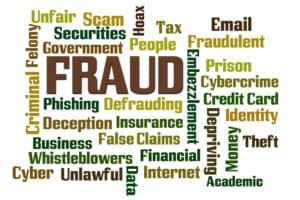
As the volume and impact of consumer fraud grows, meeting the challenge of collecting and analyzing larger volumes of data to disrupt and detect fraud remains vital.
As we all know, the past two years have seen digital adoption by consumers, businesses, and government pick up speed. Owing to the pandemic and associated lockdowns and new remote and hybrid work arrangements, years of digital innovation were packed into a few months. However, for all the benefits in improving productivity, expanding access to services, and helping consumers connect in new ways, the trend has also fuelled a dramatic increase in fraud directly targeting individuals.
A new report finds that the growth in consumer fraud in the U.S. and a number of other countries during the pandemic years of 2020-2021 exceeded the total increase seen over the previous six years. What’s more, fraud grew in variety as well as volume.
With more people than ever falling victim to the financial and psychological harm caused by fraud, public safety organizations are being challenged to change tactics and operations to keep pace with criminals. The question is: What’s the best way for public safety agencies to move forward?
The answer will vary according to the level of oversight of the agency (e.g., national vs. local), its operating model (i.e., federal vs. centralized), the nature of technology deployed or available, local laws, and the breadth of partner networks. But regardless of jurisdiction and designated responsibilities for protecting individuals from scams, what deserves more attention is updating approaches within three aspects of operational response to fraud: prevent and disrupt, collect and analyze intelligence, and detect and investigate. The updating should boost four areas of opportunity relevant across the response framework, focusing on citizens, partners, the workforce, and technology.
See also: How Digital Trust Can Overcome Fraud’s Impact on the CX
Prevent and disrupt
Given the speed, complexity, and international nature of much consumer fraud, it’s important to focus on prevention and disruption. Here are some ideas:
- Citizens. Education campaigns should be informed and improved by data analytics. As most fraud is carried out online, campaigns should be deployed and run digitally, with a focus on the most vulnerable groups.
- Partners. Coordinateefforts with partner agencies to fund joint activity and incentivize data sharing where feasible. Roles and functions may need updating to forge relationships with relevant private sector organizations and to better tap social media, telecommunications, and financial institutions to prevent fraud.
- Workforce. Work with partners and law enforcement agencies to upskill and build capacity. For example, enhanced cooperation between police and business can support prevention and disruption activities.
- Technology. Automation technologies can be used to accelerate fraud response processes, such as freezing accounts when a suspicious transaction takes place. Meanwhile, artificial intelligence (AI) tools can help investigators spot fraudsters targeting social media sites.
Collect and analyze intelligence
Improving intelligence (namely data) gathering and analysis should bolster identification of fraud patterns. Additionally, as the volume and impact of consumer fraud grows, meeting the challenge of collecting and analyzing larger volumes of data to disrupt and detect fraud remains vital. Example initiatives for agencies include:
- Citizens. Help people report fraud through their channel of choice, assess vulnerabilities, and provide advice to reduce harm and try to minimize repeat victims. Ideally, citizens should only have to report fraud once through a single point of contact reaching public safety agencies and relevant partner organizations.
- Partners. Connect intelligence gathering with agencies and private sector partners at a national and international level to improve understanding of the threat landscape. Multilateral organizations, such as Interpol, can at times help by providing intelligence and support to fill gaps in agency programs and data.
- Workforce. Look to automation to help reduce the burden of repetitive, high-volume administrative tasks. This will enable staff to analyze larger volumes of data using a range of visualizations, improving employee experience, and increasing engagement.
- Technology. Apply new and emerging technologies to advance intelligence and analysis. In particular, AI and advanced analytics, enabled by the cloud, can help agencies keep up with threats across all parts of the digital world, including the dark web.
Detect and investigate
Detecting potential incidents of fraud and gathering evidence for prosecution is a core activity for specified public safety agencies. However, given the volumes of fraud, this is an increasingly tough mandate to fulfill. The following steps could help:
- Citizens. Agencies should consider communicating with fraud victims throughout an investigation, providing updates on how cases are progressing and outcomes achieved. Such communications would also ideally help reassure victims that they are safe.
- Partners. Connected policing investigations should be conducted to maximize shared resources and ensure seamless coordination of cross-border investigations. Here, existing organizations (E.g., Interpol) offer useful platforms for collaboration, as can relationships with private sector partners through apprenticeships and work-exchange programs.
- Workforce. By providing ongoing skilling opportunities around fraud investigations, agencies can help attract and maintain talent while also improving investigation quality. Additionally, agencies should consider the engagement of civilians to augment police resources for specialist capabilities and to support investigations.
- Technology. AI and machine learning technologies offer important capabilities to help automate case prioritization and identify lines of inquiry. By using common data models, cloud, and APIs to enable interoperability across systems, agencies will be able to better connect investigations and facilitate rapid sharing of insights and developments with their partners.
With consumer fraud increasing rapidly, there’s a clear need to address the challenge with greater urgency. That means developing new approaches and processes covering citizens, partners, workforce, and technology to support the anti-fraud missions of public safety agencies. Consumer fraud represents a significant threat to citizens, to trust in public safety agencies, and ultimately to economic and national security. Dealing with it must be a collective priority for governments, public safety agencies and their citizenry, and relevant business partners, and there are abundant avenues to do so more aggressively and effectively.





























